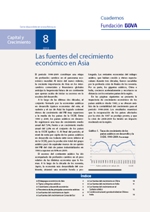Asia's weight in world GDP increased by 2.8 between 1960 and 2009
The BBVA Foundation and the Ivie have disseminated Sources of economic growth in Asia in the Capital and Growth series. The economic boom that has occurred in this continent over recent decades is examined in this note. In addition to providing an overview of Asian economies as a whole, this issue takes an in-depth look at the trajectory and sources of growth in Japan, South Korea, India and Southeast Asia.
Note no.8-2010: Sources of economic growth in Asia
 "The economic miracle seen in Asia over the last two decades are changing the international economic order", according to Ivie researcher Francisco Alcalá when describing the information contained in this note on Asia's economic boom.
"The economic miracle seen in Asia over the last two decades are changing the international economic order", according to Ivie researcher Francisco Alcalá when describing the information contained in this note on Asia's economic boom.
Alcalá highlights three effects of Asia's economic miracle in his analysis accompanying the data. Added to the pressure on commodity and non-renewable energy markets is the integration of millions of new workers into the international economic system, as well as the increased export and business opportunities that their markets represent.
"For economies such as Spain's to recover from the crisis, they need to adapt as quickly as possible to the new scenario of relative prices and international expansion," states Alcala in his analysis.
This note presents the trajectory followed by Asian countries since 1960. An example of their strong economic growth is their weight in world GDP, which has gone from representing 12.3% in 1960 to representing 33.9% in 2009. In addition to providing an overview of Asian economies as a whole, this issue takes an in-depth look at the trajectory and sources of growth in Japan, South Korea, India and Southeast Asia.
Other related notes:
5-2010 Sources of world economic growth since 1995
6-2010 Sources of economic growth in Latin America
7-2010 Sources of economic growth and productivity in Spain
9-2010 Capital endowments. International perspective
For further information on the notes in the Capital and Growth series.
The BBVA Foundation and the Ivie have disseminated Sources of economic growth in Asia in the Capital and Growth series. The economic boom that has occurred in this continent over recent decades is examined in this note. In addition to providing an overview of Asian economies as a whole, this issue takes an in-depth look at the trajectory and sources of growth in Japan, South Korea, India and Southeast Asia.
Note no.8-2010: Sources of economic growth in Asia
 "The economic miracle seen in Asia over the last two decades are changing the international economic order", according to Ivie researcher Francisco Alcalá when describing the information contained in this note on Asia's economic boom.
"The economic miracle seen in Asia over the last two decades are changing the international economic order", according to Ivie researcher Francisco Alcalá when describing the information contained in this note on Asia's economic boom.Alcalá highlights three effects of Asia's economic miracle in his analysis accompanying the data. Added to the pressure on commodity and non-renewable energy markets is the integration of millions of new workers into the international economic system, as well as the increased export and business opportunities that their markets represent.
"For economies such as Spain's to recover from the crisis, they need to adapt as quickly as possible to the new scenario of relative prices and international expansion," states Alcala in his analysis.
This note presents the trajectory followed by Asian countries since 1960. An example of their strong economic growth is their weight in world GDP, which has gone from representing 12.3% in 1960 to representing 33.9% in 2009. In addition to providing an overview of Asian economies as a whole, this issue takes an in-depth look at the trajectory and sources of growth in Japan, South Korea, India and Southeast Asia.
Other related notes:
5-2010 Sources of world economic growth since 1995
6-2010 Sources of economic growth in Latin America
7-2010 Sources of economic growth and productivity in Spain
9-2010 Capital endowments. International perspective
For further information on the notes in the Capital and Growth series.






